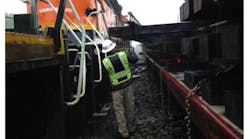Fatality Investigation: Track Panel Slides Off Forklift, Fatally Injuring BNSF Railway Foreman
The National Transportation Safety Board released a final report into its investigation of a Burlington Northern and Santa Fe Railway incident on May 25, 2015 that left one employee dead.
The incident, which happened at BNSF’s Minneapolis location, began as a forklift operator attempted to unload two track panels from a flat car. However, one panel slid off the forklift and truck two trains passing on the adjacent main track.
An engineering foreman working on the flat car attempted to avoid the falling panel, either jumping or falling from the flat car to the ground. Despite his efforts, the falling track panel struck a panel on the flat car and landed on the foreman below.
In an interview with the forklift operator, he noted that when the track panel hit the locomotive, the panel struck other unsecured track panels forcing them off the flat car.
The passing locomotive was operating at 13 mph. The temperature at the time of the accident was 63°F with wind of 17°mph, according to investigators.
According to the NTSB, the probable cause of the accident was the locomotive on an adjacent track striking track panels being unloaded and causing them to dislodge and fall on the foreman.
The NTSB listed the following contributing factors:
- A job briefing that did not address the risks associated with the work.
- The continuation of unloading activities despite being alerted to an approaching train on the adjacent main track.
- Unclear guidance on adjacent track protection.
In addition the following risk factors were not addressed during a job briefing earlier that morning.
- Proper Protection: The need for track protection when unloading track panels.
- Inexperience: This was the machine operator’s first day lifting and unloading track panels.
- Communication: There was no communication about a plan to stop working if the foreman saw a train approaching. Because the group had not specifically discussed the strict adherence to stopping work, the unloading machine operator continued to lift the panels because he thought he had time to finish.
The NTSB specially questioned the peer-to-peer safety culture observed at the BNSF railway location. The agency noted that the work crew should have questioned the safety of the assigned work and made adjustments based on the risks identified, which could have prevented the accident.
During the morning’s job briefing, the foreman discussed general work planning and the adjacent track rules, but he did not cover hazard recognition and mitigation associated with the specific tasks that were to be completed during the day’s work.
The agency responded to this, stating in its report:
Before beginning any roadway work, the roadway worker in charge (RWIC) must consider safety first, then recognize and analyze the multitude of risks and hazards of the job and work environment and take steps to mitigate the hazards. Second, the foreman must discuss these risks and hazards with all workers in a job briefing. Finally, additional job briefings must be conducted any time the work changes or a new person joins the work crew.
The agency concluded that the primary safety issue which caused this accident was a lack of basic safety awareness. The entire investigation report can be found at NTSB.gov.
Post-Accident Measures
The day after the incident, BNSF conducted a safety stand-down with its engineering personnel in the Minneapolis area. The company discussed the incident and emphasized safety. Two days after the accident, a companywide safety bulletin was issued addressing the incident and providing a question-and-answer section about adjacent track protection with reference to existing rules.
As of Nov. 2, 2015, BNSF had a developed a formal training process focused on the safe operation and machine limitations for heavy equipment operators on construction crews. BNSF now advises that all operators would receive a third-party evaluation. The company also created a formal briefing document that was shared with engineering employees regarding track panel loading and unloading to focus on best practices on handling specific kinds of material in different situations.
Lastly, BNSF clarified their adjacent track rules to ensure better understanding. Those discussions are now a required part of the daily job safety briefing for construction crews.
Title 49 of United States Code provides the National Transportation Safety Board with the authority to investigate and establish the facts, circumstances, and cause or probable causes of a railroad accident in which there is a fatality or substantial property damage, or that involves a passenger train.
